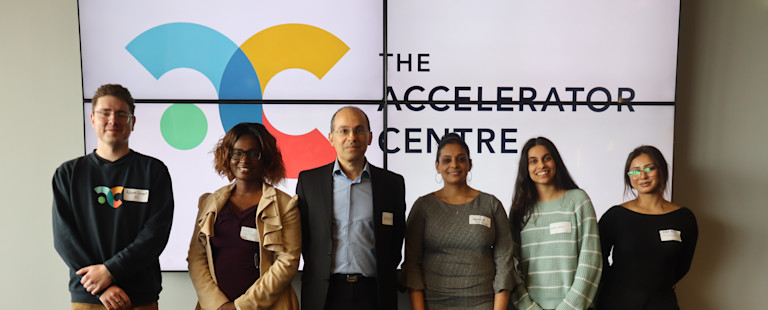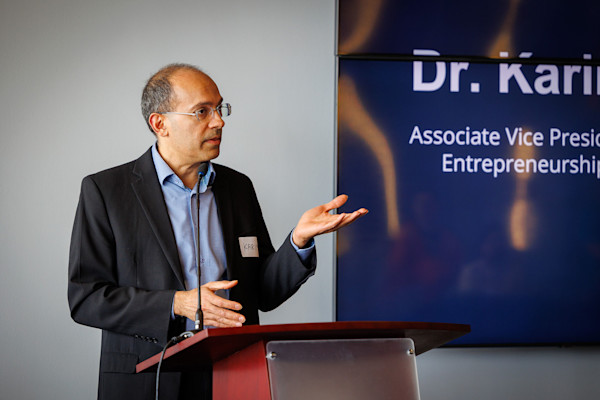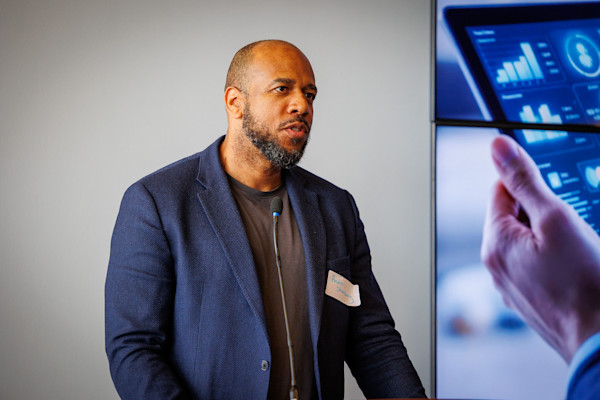From Ideas to Impact: Stories from the Global Impact Creator Program
The Global Impact Creator Showcase highlighted groundbreaking innovations and the passionate changemakers driving meaningful, sustainable change. Tabatha Laverty, VP of Marketing and External Relations at the Accelerator Centre, said the program is a perfect example of the importance of social innovation within the broader innovation ecosystem.

On Thursday, April 3, 2025, the Accelerator Centre community and guests gathered for the Global Impact Creator Showcase. It was an inspiring afternoon highlighting visionary entrepreneurs dedicated to solving global health and social challenges.
Adam Dougall, Program Manager at the Accelerator Centre, opened the event, welcoming attendees and setting the stage for the showcase.
“Since September, our Global Impact Creator participants embarked on an ambitious and personal journey, diving into these real-world challenges and building innovative solutions that have the power to transform lives,” Dougall said.
Dr. Karim S. Karim, Associate Vice-President of Commercialization and Entrepreneurship at the University of Waterloo, delivered the opening keynote. Karim said the program’s focus on ideas that intersect sustainability and social innovation is a unique approach that needs to be explored more.

"Oftentimes, when people hear social innovation or social impact, they think charity. But I think as you do social impact, more people are starting to realize the value to society in giving back to the community. It’s good to marry the social impact element with the sustainability element, so you have something that’s evident,” Karim said.
Unlike traditional incubation programs, the ideas explored by participants in the Global Impact Creator program do not always end with a new venture. Tabatha Laverty, VP of Marketing and External Relations at the Accelerator Centre, said the focus of the program is exploring how entrepreneurial ideas can make a significant impact in underserved communities.
"Sometimes what the participants learn is that there is no commercial solution to this. This is something that needs to be tackled by governments or the not-for-profit sector. That’s still valuable learning,” Laverty said.
Following the keynote, four of the program participants presented their initiatives. Hana Karim, a biomedical engineering student, discussed her project deploying mobile diagnostic clinics to underserved communities in Kenya. The project first deployed an x-ray system in a community hospital before pivoting to an x-ray system in a repurposed ambulance.
"My biggest goal is to bridge the healthcare gap for low-income communities. I think a lot of change should be made in low-income and middle-income communities and from the obesity change in our communities here, but it starts by going out,” Karim said.
Lidya Konlan from Ghana presented her innovative approach to empowering women through sustainable mushroom farming. Her initiative focuses on providing women with agricultural skills and resources, helping them achieve financial independence. Her project is creating sustainable economic opportunities by transforming agricultural waste into valuable products.

"We are identifying raw materials that are available within this community, so we can easily transform them into bubble for women to take advantage of. So we are building that community so that it becomes like an ecosystem for them to take advantage of and then try and be profitable,” Konlan said.
Dr. Nadine Furtado and Dr. André Stanberry, from the University of Waterloo’s School of Optometry, shared their team's advancements in optimizing eye care. Their project leverages technology to streamline eye exams, improve patient care outcomes, and make eye care services more accessible. The team's goal is to remove barriers that prevent individuals from accessing quality eye care.
"So what we’re proposing is developing a technology that’s going to help streamline eye exams, streamline the flow so that we can optimize patient care outcomes and help practices grow. Part of making eye care more efficient is also allowing it to be more accessible to individuals as well,” Dr. Furtado said.
Dr. Stanberry added that the global population is eclipsing the number of available optometrists and other eye health professionals.
"We're coming towards a cliff in eye care delivery, where the population is growing twice as fast as the number of providers. We don't expect that we're going to have many more eye care providers, but what if each provider can see more patients,” Dr. Stanberry asked the audience.

Ayra Ali, a University of Waterloo science student, shared insights from her entrepreneurial journey in the Global Impact Creator program. She said the importance of adaptability was one of the most impactful lessons from the program. Ali's experiences show the value of embracing change and remaining passionate about creating a meaningful impact.
"The good thing about being here in this program is I learned how to build a startup. The great thing that I learned is that it’s okay to pivot. A little bit of passion is still enough passion to keep something going, and a little bit of impact is still enough impact to call yourself a social impact entrepreneur,” Ali said.
The Global Impact Creator Showcase highlighted groundbreaking innovations and the passionate changemakers driving meaningful, sustainable change. Laverty said the program is a perfect example of the importance of social innovation within the broader innovation ecosystem.
"The Global Impact Creator Program is a powerful reminder that innovation isn’t just about building the next big tech company—it’s about using entrepreneurial thinking to solve real-world problems. Social innovation has a critical place in our ecosystem, and this program proves that founder don’t have to choose between purpose and profit,” Laverty said.